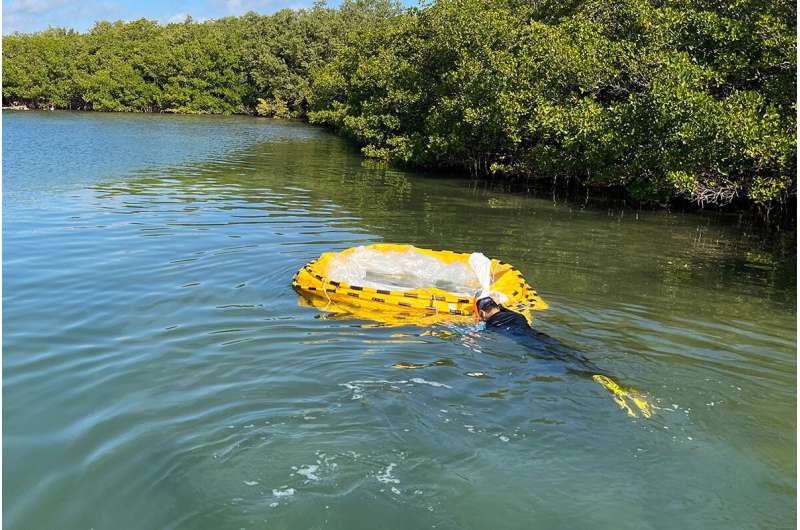

A potential treatment for Florida’s devastating red tides has taken another step toward widespread deployment after successful testing in Sarasota Bay.
Additional detailed data analysis is required to confirm results, but UCF Assistant Professor of Biology Kristy Lewis is encouraged by the large-scale test of a red tide mitigation technology called clay flocculation that was performed in partnership with Mote Marine Laboratory.
This study is the first successful test of any red tide mitigation technology in open water using large water column containers called limnocorrals. These tubes—about six feet in diameter—extend from the waters’ surface to the ocean floor, allowing scientists to test real ocean conditions within a controlled setting. Think of it like a giant test tube.
Experts and technicians from Mote Marine Laboratory provided the necessary resources to set eight limnocorrals into Sarasota Bay. Four columns were treated with a fine spray of the clay solution, while the other four served as a control.
Clay flocculation works by the clay attaching to the Karenia brevis algae, which is responsible for Florida red tide, and sinking them to the ocean floor. Lewis has spent the last three years carefully testing the impact of introducing this non-native mineral into the ocean ecosystem. She’s not only looking for changes in the water’s nutrients and quality, but also evaluating how the clay impacts the health of invertebrates like blue crabs, sea urchins and clams.
“We want to make sure the cure is not worse than the disease,” she says.
Initial plans for the large-scale test were simply to measure the impact of the clay on the ecosystem, but the unexpected appearance of an actual red tide event heightened the realism of the experiment. Initial results suggest the clay performed as expected, but there’s still a question of whether the algae’s toxins remain dormant or active on the ocean floor. Water samples collected during the experiment should provide an answer.
The tests are the latest in a long chain of progressively larger-scale experiments—from tiny test tubes, to 5-gallon tanks and 300-gallon replicas of Sarasota Bay. Next steps depend on the outcome of test results, but there are already plans to investigate what happens to the clay-coated algae when it’s used near seagrass beds and then distributed by tide and currents.
More than a dozen people were involved in setting up and running the experiment over the course of four days, including Emily Hall, co-investigator on the grant and senior scientist and program manager from Mote Marine Laboratory. Lewis also credits UCF assistant professors of biology Michelle Gaither and Robert Fitak for providing the necessary technicians and equipment to carry out the experiment. Doctoral student John Kristoffer “JK” Andres will analyze the outcomes of this experiment as part of his dissertation research.
Visiting Sarasota, Florida, in the middle of a red tide event reminded Lewis just how critical the research is to restoring the state’s coastal health and the corresponding fallout on its economy. Lewis says she’s prepared to go another three years if that’s what it takes to find a concrete solution to red tide.
“I want to take every precaution and do our due diligence to ensure we are not doing more harm than good,” she says. “When it’s time to convince policy makers and the people who can take action, we will be prepared.”
The work is the next step in the Lewis’s research to find a method to combat red tide.
Provided by
University of Central Florida
Citation:
Research team uses 6-foot ‘test tubes’ to study red tide (2023, March 15)
retrieved 15 March 2023
from https://phys.org/news/2023-03-team-foot-tubes-red-tide.html
This document is subject to copyright. Apart from any fair dealing for the purpose of private study or research, no
part may be reproduced without the written permission. The content is provided for information purposes only.